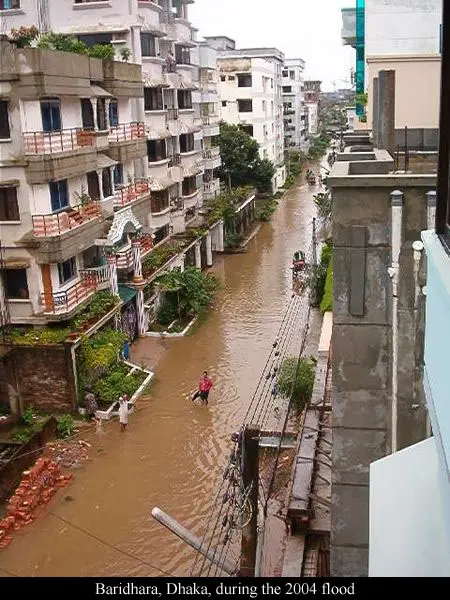Climate and Floods – See recent Extreme Flooding
Meteorologic floods are by far the most common of the types of floods in the human experience, affecting parts of the globe every year. Such floods can bring good, such as the fertile soils formerly brought to the Nile Delta by annual flooding. However, large floods are mostly known for their catastrophic loss of life and property, such as in China and Bangladesh which repeatedly devastated by floods – Bangladesh lost 300,000 people in November 1970 and more than 130,000 in April 1991, from cyclone-induced flooding, and the massive flooding of the Yangtze River in China in 1931 caused more than 3 million deaths with a further 2 million in 1959 from flooding and starvation.
The IPCC sees changing climate and floods as “the most widespread direct risk to human settlements…, driven by projected increases in rainfall intensity and, in coastal areas, sea-level rise. Riverine and coastal settlements are particularly at risk, but urban flooding could be a problem anywhere that storm drains, water supply, and waste management systems have inadequate capacity. Flood magnitude and frequency could increase in many regions as a consequence of increased frequency of heavy precipitation events, which can increase runoff in most areas as well as groundwater recharge in some floodplains.”
Bangladesh is a very low lying country, (only 3-7 feet in most parts). Climate change and floods exacerbated by global warming in the last few years has set in motion the rise in sea water levels. At the narrow north tip of the Bay of Bengal, tropical storms can whip up wind speeds to 140 mph sending waves(up to 26 feet tall)crashing into the coast. The shallow sea bed and the fact that water coming down from the rivers Ganges and Brahmaputa can not escape when the water level rises all contribute to the severe flooding of the Bangladesh coastline.

Flooding causes more damage in the United States than any other severe weather related event, an average of $4.6 billion a year in the past 20 years (1984-2003). Flooding can occur in any of the 50 states or U.S. territories at anytime of the year.
A flood generally occurs with prolonged rainfall over several days, intense rainfall over a short period of time, or an ice or debris jam causes a river or stream to overflow and flood the surrounding area. Melting snow can combine with rain in the winter and early spring; severe thunderstorms can bring heavy rain in the spring and summer; or tropical cyclones can bring intense rainfall to the coastal and inland states in the summer and fall.
A flash floods occur within six hours of a rain event, or after a dam or levee failure, or following a sudden release of water held by an ice or debris jam, and flash floods can catch people unprepared. There is not always a warning that these deadly, sudden floods are coming, and the use of the word “flash” is synonymous with “urgent.”
“By 2025, half the world’s population will be living in areas that are at risk from storms and other weather extremes,” the World Water Council said, citing evidence gathered by U.N. and other experts. The economic cost of changes in climate and floods will be huge, especially for poor countries that are likely to bear the brunt of these events. The phrase Climate and Floods is something we will hear more of in the years ahead.
